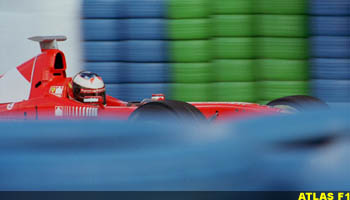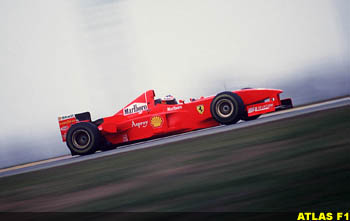|
The expression on Michael Schumacher's face said it all. Regardless of whether he was right or wrong - the ice cold German was fuming. Schumacher, renowned for his low blood pressure, was already on the verge of explosion when he made his way to the pits in a tricycled Ferrari, after colliding with McLaren's David Coulthard, bringing an end to an almost certain victorious race. "Michael, calm down," was the repeating message from Ross Brawn on the radio, as he observed worriedly the German's personal telemetry showing a higher heartbeat rate than ever.
 But
Schumacher cannot calm down, not even after three days of a rest at his recently purchased estate in Switzerland. "I could have gone to Monza leading the World Championship by three points, three points!" he says, and it would be a safe bet to say, that Schumacher - who rarely looks back at his own actions - is still reliving the crucial seconds that might eventually cost him this year's title. It would be a safe bet, anyway, for anyone who watched Schumacher prepare in the last couple of weeks for the Belgian Grand Prix. But
Schumacher cannot calm down, not even after three days of a rest at his recently purchased estate in Switzerland. "I could have gone to Monza leading the World Championship by three points, three points!" he says, and it would be a safe bet to say, that Schumacher - who rarely looks back at his own actions - is still reliving the crucial seconds that might eventually cost him this year's title. It would be a safe bet, anyway, for anyone who watched Schumacher prepare in the last couple of weeks for the Belgian Grand Prix.
Hungary's Grand Prix win was a mere surprise, a bonus. The table overturn, in Schumacher's plan, was to happen at his favorite track, Spa Francorchamps. And everything that he did in the last few weeks, was directed at that race on Sunday. "In order to beat the McLarens," wrote Peter Windsor in the latest F1Racing magazine issue, "Michael had to take more risks than most drivers take in a decade." And indeed, Schumacher was never seen - on track and off track - as blindly dedicated to a mission as he was, leading to his eruption in the McLaren's pit garage on Sunday.
The writer Hans Borchert escorted Michael Schumacher in the last three weeks, following him everywhere he went. He spoke to his friends, watched him work-out, test at the Fiorano track, but most of all, watched him in his loneliness. For Schumacher, it seems, is - after all - very much a lonely man, secluded by his roaring ambitions to bring the legendary Italian team Ferrari its first World Championship in nearly two decades. He has the loneliness of a Long-distance Driver, writes Borchert.
There was something in the air during the days leading up to the Belgian Grand Prix in Spa-Francorchamps. Something unmentionable, which gives one the shudders. Racing driver Michael Schumacher, 29, is tempting fate with everything in his power. His commentaries, his driving style, his muscular, well-trained body, his facial features, his every glance betray that this man has just one thing on mind. Close friends have been worried for ages. For the first time in the career of the two-time World Champion they are anxious. "Anxious that Michael will take it too far," is how Jurgen Dilk, one of his early backers, puts it.
Recently he called him and entreated him: "Michael, remember 1994. Think of Ayrton Senna's end at Imola. You are in the same situation. You often overstep the limit."
"I know," replied Schumacher with unusually frank answer, "but I owe it to myself and my team."
"It's crazy the way he rubs his arse down", said one hard-bitten Ferrari worker during the Hungarian 77 laps race. "I admire Michael immensely for the way he handles the pressure," says Sauber driver Jean Alesi, one of the few real friends Schumacher has between the current drivers. "For me, as a racing driver, this is sensational. And the way he handles the extreme curves, how he finds the ideal course, is fantastic. Earlier his style tended to be mathematical, very calculated, like a machine. Now it is all so flowing and quite natural. Only one other has ever driven like this: Ayrton Senna, during his very best time."
 But
everything has its price. Even for Schumacher. Little by little, he is beginning to show his age. You can read on his face, on every TV monitor, the "I will" and "I must". But occasionally, when you are right up close, like recently on Ferrari's own racing course at Fiorano, the multimillion Dollar face says, "I am so tired." But
everything has its price. Even for Schumacher. Little by little, he is beginning to show his age. You can read on his face, on every TV monitor, the "I will" and "I must". But occasionally, when you are right up close, like recently on Ferrari's own racing course at Fiorano, the multimillion Dollar face says, "I am so tired."
In three days he ran exactly 1409.4 Kilometers of tests, a record distance for any Formula One driver. And yet, even at Ten at night, after he's been up for over 16 hours, Schumacher has a business meeting with two solicitors from London, their figures throwing long shadows in the light of the full moon as they await the driver to finish his day's course. Later, the three will go off and eat together, to discuss various financial and contract details. But as they await, it is the solicitors yawning rather than Michael. "How he does all this I cannot imagine. Even from just watching I am dead tired," mumbles a Mr Clark.
That is what the days and nights in Fiorano are like. Indeed, it is one of the most curious places on earth; three buildings stand there in the middle of a brown, sun-tanned landscape surrounded by a fence which is as tall as a human-being and is guarded day and night. The whole ensemble was once part of a farming complex, with stables, storage barn and living quarters. In fact, visitors are still greeted by a pottery figure of St Anthony, the patron saint of domestic animals. And right at the entrance there is the white marble bust of the Madonna. Anyone who wants to, can kneel there and cross himself ten times. Schumacher, hardly a religious figure, never does.
Enzo Ferrari made the farm his headquarters in 1972. He had the racing circuit built around it and, in keeping with the taste of the time, installed a filling station. To this day, Enzo Ferrari's office and his small conference room are still kept in the main building. Nothing has been changed, and it looks as if the old boy might slip in sometimes at night and sit right down at the heavy oak desk. Telephone and short-wave radio, even the magnifying-glass reading lamp are all in place, well-dusted and polished up to perfection.
But what would the Commendatore himself have thought of Schumacher? Ferrari elders say he would have admired his driving, but the two would not have befriended. "They would have nothing in common, except the love of racing," says an old guard at Fiorano. Well, Enzo Ferrari is reputed to have built cars in order to impress women, hardly the notion you'd get from watching Schumacher, the opposite of a playboy. Enzo supposedly enjoyed female company until late in his life, and in that very spot where several adventures are reported to have taken place, Michael Schumacher now spends the nights like a hermit.
He sleeps there in the most modest surroundings - a bed, a sofa, a chest of drawers and a sports-bag with very few clothes. The only human companionship he has is his physio-therapist Balbir Singh, sleeping next door. They share a toilet and a shower, but hardly share a conversation; Schumacher is seldom alone, but often very lonely.
But what seems to some so Spartan is actually considered by Schumacher himself a great privilege and absolute luxury. No Ferrari driver before him ever lived in this house and none ever shared what the Commendatore so treasured: the quietness and remoteness Fiorano has to offer. In the former shed where ploughs, harrows and barrows once stood, a complete physical fitness studio has been installed for Schumacher, and the lights are often on until after midnight. And at other times, you can see his shadowy figure jogging all alone along the asphalt track to the accompaniment of grasshoppers chirping. That is what he likes, that is all he can focus on. Anything else is a distraction.
 "I
do
nothing but train and drive," says a very serene Schumacher, "and I have no time for playing around." Indeed, the test program now, shortly before the end of the season, is almost wider than at the beginning of the year. New brakes have to be tried out; shock-absorbers and suspensions have to be checked; new aerodynamic components tested for suitability; and racing situations are simulated. "I
do
nothing but train and drive," says a very serene Schumacher, "and I have no time for playing around." Indeed, the test program now, shortly before the end of the season, is almost wider than at the beginning of the year. New brakes have to be tried out; shock-absorbers and suspensions have to be checked; new aerodynamic components tested for suitability; and racing situations are simulated.
Then Schumacher goes the whole distance, right to the limit. If any other Grand Prix driver has to endure the full distance once, maybe twice, every fortnight, Schumacher does it twice a week at least. And his Ferrari is looking as if it had been hit by a round of machine-gun fire. All over the carbon-fibre chassis there are gashes and holes, and the mechanics have all sort of things to screw on. Their mutual motto: put the lid on and take it off again. Schumacher's vehicle has had so many adjustments made to it, it is by now referred to as "the mobile building site".
On one of those long testing days, Schumacher was doing over 160 laps - quite a boring sight, really, watching the man punch in a lap after lap, with no Murray to shout at your ear or other drivers to add to the tension. On the small grandstand, in the shade of a plane tree, a few spectators look on wearily. Suddenly, his car slips off the track and ploughs across the adjoining gravel. Everyone wakes up instantly: the fire-service, the paramedics and, above all, the mechanics who are slacking around eating ice creams. They all dash over, but things are already under control - Schumacher disengages and reverses over the grass verge, back onto the track.
Someone says: "You sometimes forget that even here a mistake could cost him his life."
How does he endure it? "Practice," says Michael Schumacher and grins. He says he has for some time now been the equivalent of an experienced professional trucker because this year, with training, tests and races, he has chalked up 30,000 kilometres. At an average speed, remember, of well over 200 kph.
But that is not all. During training he packs his days full of other obligations, including several business meetings, press interviews, sponsorship luncheons and he even manages to fit in four takes for a new Fiat commercial between several test runs.
Michael Schumacher takes life at a breathless pace, always looking vital. But early in the morning, when he is sitting up in his room, he looks weak, his eyes bloodshot from the strain of the previous day. It seems as if he must gather up strength to get going again.
You ask him, "How much is too much?" and also: "How fast is too fast?"
His answer, always the same - "Wait and see."
|

